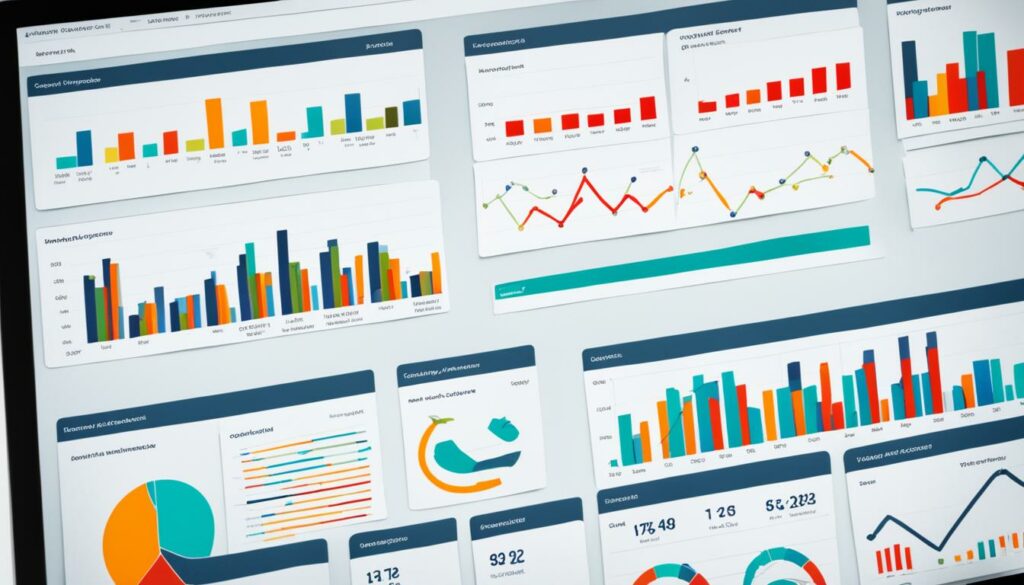Menu

Do you know that companies using competitive intelligence might do 15% better than their rivals? Understanding your competition, customer behaviour, and the market is key. It keeps you in front in today’s quickly changing business world. Competitive analysis helps companies make their marketing, sales, and pricing better. It also finds what customers want but haven’t found yet.
Checking out your competitors closely gives you very important info about the market. This helps tweak your products to match what the market wants right now. This doesn’t just win you a lead but also makes your brand a market leader.
In the business world, competitive market analysis is like a guide. It helps companies understand what customers want and how the market changes. This type of analysis looks at what makes companies different and their strengths and weaknesses. It includes details like what they sell, how they set their prices, and what their customers say.
Studying the market helps businesses find empty spots they can fill with new products. It also reveals trends that can guide better marketing and sales. Analyzing the competition gives companies a plan to grow smarter, not just react. This process helps to stand out, learn from strong rivals, measure success, and know customers better.
Remember Blockbuster, the video rental giant that failed in 2010? Its story is a big lesson on ignoring market shifts and competitive threats. Learning from such cases helps companies see what their customers really want. By looking at successful market leaders, they can plan how to grow and pick up useful strategies.
Understanding what competitors do, the products they offer, and their target customers is crucial. Let’s look at the key steps of this analysis process:
| Steps | Actions | t
|---|---|
| 1. Identify and Categorise Competitors | List all direct and indirect competitors | t
| 2. Determine Market Position | Analyze each competitor’s position in the market | t
| 3. Benchmark Key Competitors | Extensively compare strengths, weaknesses, and strategies | t
| 4. Unpack Competitors’ 4 P’s | Examine product, price, place, promotion | t
| 5. Conduct In-Depth Research | Gain actionable insights and stay competitive | t
Competitive market analysis is not about copying others. It’s about using what you learn to do better. Doing this well makes a business ready to adapt, full of new ideas, and able to compete well.
Examining the competitive market is vital for businesses. It helps them adjust their sales and marketing to better reach customers. They also use this information to set their prices right. Plus, it shows where they can create new products not found in the current market. This thorough study pushes companies to improve. It helps them succeed in their industry by making better moves.

Studying the competitive market closely gives companies a clear view of where they stand. It helps them adjust their sales and marketing strategies to beat their rivals. In fact, I found that 78% of businesses do better when they know what their competitors are doing. Knowing what customers like means firms can make adverts and messages that people really connect with.
Setting the right prices is key, and looking at what competitors are doing helps a lot. Companies can match what the market expects and still make a profit. For example, comparing products and their prices can boost sales for some by 20%. This also helps in pricing things just right against others in the market.
Watching the market closely also helps teams come up with new products. They spot gaps in what’s available and come up with items that are needed. One study showed by doing this, some businesses grew their market share by a quarter. This keeps their products up to date with what people want and makes sure they stay competitive.
| Benefits of Competitive Analysis | Impact | Statistics |
|---|---|---|
| Sales and Marketing Optimisation | Enhanced Engagement | 78% of companies outperform competitors |
| Pricing Strategies | Increased Conversion Rates | 20% increase in specific segments |
| Product Development | Increased Market Share | 25% increase by identifying market gaps |
Market analysis is key for businesses wanting to stay ahead. It helps understand the market landscape and what makes a business succeed. This includes looking at competitors, understanding what drives consumer choices, and following trends. All this information supports smart market navigation.
Analysing competitors aids in understanding the market landscape. It starts by figuring out who your competitors are. Then, placing them in different categories based on their position helps. Next, comparing them on quality, prices, feedback, and offerings is essential. This systematic approach reveals what your business is up against.
Getting to know consumer behaviour is crucial. It helps businesses connect better with their audience, boosting satisfaction. Researching what customers want allows companies to refine their products and services. This makes their offerings more aligned with what customers seek.
This in-depth examination also spotlights new trends. These trends can drive future business strategies.
Staying informed about industry trends is a must for being competitive. Analysing market fluctuations points out growth areas and dangers. Quickly adapting to these changes sets up companies for success. Looking at trends also informs what new products are needed. Using tools like sentiment analysis or product studies keeps a business at the front.
| Component | Key Focus |
|---|---|
| Competitor Analysis Techniques | Identifying and categorising competitors, determining market position, benchmarking key competitors. |
| Consumer Behaviour Insights | Gathering and analysing data on consumer preferences, aligning products with market needs. |
| Industry Trends and Patterns | Tracking market shifts, identifying growth areas and risks, guiding product development. |
Every month, the United States sees over 400,000 new businesses start. This makes using smart market analysis tools very important. These tools give insights into what competitors are doing and what customers think. By using these tools, businesses can stay ahead.

Looking at what your rivals do online is key. It shows what they sell, their goals, and who they’re aiming at. This info is gold for creating better marketing plans. It helps businesses change what they do to better meet what customers want.
Reports and publications about your market are full of info. Organisations like the U.S. Census Bureau share lots of data. This helps businesses see what they’re doing well at and what they need to work on. It also shows where they can grow.
What your customers say about you is very important. Using tools like SurveyMonkey, businesses learn directly from the people who buy from them. This makes it easier to improve their products and make them suit what customers are looking for.
Speaking directly with customers is a powerful way to learn. Tools like Google Trends can help create detailed customer profiles. They show businesses what customers like, what they don’t like, and what they need.
By combining all these tools, businesses can have a strong competitive game. This means always keeping an eye on what other businesses are doing and what their customers are saying. It allows for making marketing strategies that are always up-to-date and effective in the changing market.
Market research and analysis are vital for businesses that aim to do well in a tough market. They help find out more about competitors and guide big decisions for company growth. This means setting clear goals, spotting key rivals, and using special tools to understand the market.
First, you must set your goals straight. Having a clear focus makes research more effective and useful. Your aims could be learning about competitor insights, noticing gaps in the market, or figuring out how to measure success. This direct method saves time and improves the quality of what you learn.
After you have your goals, it’s time to look at your main competition. Splitting them into direct and indirect rivals gives a wider view of the market. By checking their positions, products, prices, and what customers say, you build a strong understanding. This knowledge is key for making smart business plans.
Lastly, use market intelligence analysis tools. These are crucial for sorting through tons of information. Through detailed analysis, businesses can find insights that aren’t obvious at first glance. This leads to decisions that support business strategies. Keeping up with market research and analysis puts businesses in a leading position.
Gathering competitive intelligence is more than watching your rivals. It means you find out a lot about your customers and the deals your rivals make. This helps your business thrive by making smart decisions and staying ahead.
Competitive intelligence is crucial for decision-making and business performance. It enhances market understanding, sets benchmarks, and supports informed decision-making.
To gather intelligence well, start by picking out the main competitors and setting goals. This stops you from getting too much information. Instead, you focus on what you can use to boost your strategies. By collecting data smartly from many places, you get a full picture of your competition.

Useful sources of intel are customer data, feedback from the sales team, and keeping an eye on social media. Tools such as Sprout Social, Ahrefs, G2, and Craft.co make it easier to gather and understand this information. They help businesses figure out what the market needs and how to react to new chances and risks.
A good intelligence strategy also looks at what customers and competitors in technology are doing. Listening to what people say online gives you insights about your brand and others. Knowing what tech your competitors use helps in planning your strategies. Also, keeping watch on their new products and deals helps you stay ahead.
Managing the insights you get all in one place helps your whole team. They can easily get the latest information they need. This makes everyone make better choices. Doing this regularly helps keep your business sharp and ready for any market changes.
It’s crucial for businesses to do a detailed competitor performance analysis. This helps them deeply know their market position. By looking at financial comparative analysis, companies can find important insights. This helps with making smart decisions and planning for the future.
It’s key to know the types of competitors out there:
To do a good competitor performance analysis, follow these steps:
Looking at several factors can help size up your competition:
If you don’t keep up with market trends, you might end up like Blockbuster in 2010. Learning from competitors’ moves can help you stay ahead and catch market changes early. Keeping an eye on competitor performance analysis with financial info shows the market’s current state. It also helps plan for future business and investment.
Doing a competitive analysis every few months helps you stay alert and ahead of changes.
Here’s a quick look at what affects the market:
| Component | Details |
|---|---|
| Niche | Small, specialised market with specific needs |
| Contenders | Competitors actively vying for market dominance |
| Leaders | Market front-runners with significant market share |
| High Performers | Exhibit strong performance, often excelling in specific domains |
Taking lessons from financial comparative analysis can make businesses stronger. It helps them grow steadily and stand out in their markets.
It’s key to do a thorough SWOT analysis to understand where your business stands. This analysis looks at your business’s strengths, weaknesses, opportunities, and threats. It helps in making smart decisions and finding chances for growth.

Knowing what your business is good at and where it lacks is very useful. For example, your business might be known for its strong brand, various products, and happy customers. This keeps you ahead. But if you have issues like high prices, you’ll know where to focus to get better. Use info from your competitors’ websites, financial reports, and what customers say to learn this.
Opportunities are chances for growth in the market. A SWOT analysis can highlight these, like new trends, markets, or product improvements. Grabbing on to these can keep you competitive. It’s also important to see threats, such as changes in technology or new competition. Symanto’s AI tools can help by understanding how people feel and how your competitors are doing, in sectors like online shopping and gadgets.
| Element | Description | Example Source |
|---|---|---|
| Strengths | These are internal advantages that make your business strong. | Financial reports and awards from the industry. |
| Weaknesses | These are internal issues that hold your business back. | What your employees and customers say about you. |
| Opportunities | These are outside chances that could help your business grow. | What’s new in the market or what customers want. |
| Threats | External dangers that your business faces. | When competitors start new things or laws change. |
A well-done SWOT analysis is key to knowing your market and finding ways to thrive. It’s crucial for keeping your business strong and quick in a changing market.
It’s crucial to know what the market needs to match your product with what consumers want. You can group customers by where they are, who they are, and their actions. Then, focus your product’s details to meet their specific needs.
In a poll from 2012, a huge 91% said what they do every day fits with their company’s goals. This shows how important it is to make sure your product meets what the market desires. Gathering feedback from surveys and reviews helps keep your product aligned with what consumers need.
Being flexible in how you develop your product is key. Jim Chriss believes in a changing strategy to meet new market challenges and your company’s goals. A SWOT analysis, recommended by Ogo Amadi, helps you understand what customers need now and in the future. This leads to continually improving and better meeting market expectations.
Wendy Shore Rosano says understanding why customers buy and what hurdles they face is vital. This info helps tweak your product to fit the market’s demands. Segregating customers by how quickly they adopt new tech shows that trendsetters might pay more for cutting-edge products, Nile Harris has found.
To create a great product, you must deeply understand your customer groups. Design your product to fulfil their needs and see satisfaction and sales rise. Richard D. Amburgey stresses the need for constant feedback through social media and brief surveys. This keeps your product in line with what your market wants.
| Criteria | Importance | Impact |
|---|---|---|
| Customer Segmentation | High | Targets specific needs, improves satisfaction |
| Feedback Collection | Crucial | Identifies gaps, drives product refinement |
| Flexibility in Strategy | Vital | Adapts to market changes, ensures relevance |
| SWOT Analysis | Significant | Continuous improvement, strategic alignment |
| Understanding Motivations | Essential | Tailors products to consumer needs |
To align your product with the market’s needs, take a broad approach. Focus on improving your product’s details and making sure it meets consumer needs. This means doing thorough research and being ready to change strategies. These are the secrets to making your product a hit and staying relevant in the market.
Understanding what customers want is key for any business. By looking closely at consumer preferences through sales data and who their customers are, companies can find out what they like to buy. This helps them forecast future trends and see where the best opportunities are.
It’s not just about collecting information, though. Using modern tools, businesses can make their marketing more effective. They might see a big improvement in their returns, like a 140-400% rise over three years. This helps companies better meet what their customers want and keep them coming back with smart strategies.
An in-depth analysis of the market can show where a business can grow and warn about risks. Armed with these insights, businesses can tweak their products to match what consumers really need. This kind of effort can make their products even more appealing.

Tools like conjoint and sentiment analyses help with different but important tasks. Conjoint looks at what product features customers like most, aiding in product and price planning. Sentiment analysis, however, explores feelings through personal input. This is vital for keeping an eye on what people think about a brand and understanding their honest thoughts.
It’s always important to see what rivals are up to. Companies that keep an eye on the market are less likely to face challenges like Blockbuster did. They use tools such as Google Analytics, HubSpot, and IBM Watson to spot trends, which helps them make smart strategies and stay in the lead even when the market is tough.
| Aspect | Benefit |
|---|---|
| Sales Data Analysis | Identifies High-Value Areas |
| Customer Profiles | Personalises Marketing Efforts |
| Conjoint Analysis | Facilitates Strategic Product Development |
| Sentiment Analysis | Enhances Brand Monitoring |
So, putting deep thought into what customers like, being ready to meet their needs, and using advanced tools makes companies more likely to succeed over time.
Optimising how people see your brand is key. You need to use smart brand strategies and show your unique benefits. This helps your business shine in a crowded market.
Brand differentiation is crucial for standing out. To lead the market, companies must keep introducing new and better products. They should also focus on what makes their products special and how they solve customer problems. Offering products at lower costs due to efficient production can also give a big advantage.
Small to mid-size businesses often forget to focus on delivering top value. But, that’s very important for staying ahead. Looking at how your competitors operate, sell their products, and offer customer services can help. This insight can guide you in making your brand different.
Having a strong value proposition is at the heart of market success. You must build good relationships with customers. This means being present on social media and responding to what customers need. Companies that really get their customers’ needs can tailor their solutions to fit perfectly.
Know your audience and how you can meet their needs. This is crucial for new businesses and those expanding. When marketing, aim to be remembered by clearly showing your unique value. This appeals to your target market.
62% of customers say one experience shapes their view of another brand. So, having a clear and strong value proposition is vital. It not only brings in more customers but also keeps them loyal. Loyal customers attract more business and investment, boosting your revenue in the end.
Setting a timeline for your market strategy is vital. It helps keep track of progress, stay motivated, talk better, and meet deadlines. This leads to success.
Keep updating your market strategy using smart branding and a clear value message. This will help your business stay on top in the market.
Using competitive intelligence is crucial for any business’s strategy. It turns knowledge into plans that keep them in front. This way, they lead the market, not just follow it.

Understanding what’s going on in the market is key. This means keeping an eye on what really matters. Figuring out who your customers are and what they want is essential.
Here’s how to get things moving:
It’s also wise to know who’s doing the best in the market right now. Seeing what your competition is up to and how well they’re doing matters. It helps you do better through learning and smart moves.
Understanding how others win customers is smart. It points out where there might be a chance for you to do better. Learning from the best brings fresh ideas into your marketing approach.
And it’s good to keep an eye on what your rivals plan for the future. Knowing their next big steps helps you get ready. This makes your business strong and ready for whatever comes next.
Using tools to keep an eye on what your competitors do online is clever. It’s a key part of staying informed about the market.
Competitive intelligence mixes with business smarts to guide smart choices and better operations. This keeps a business strong in the fast-paced market world.
Read more on how to use competitive intelligence for growth.
Lastly, blending what you know about the market with your own data helps spot trends early. It ensures your strategies are sharp, always keeping up with the market.
Using competitive market analysis in business means turning lots of data into plans that work. This helps decision-making become more strategic and makes a company’s operations stronger. The trick is to change what you know about your competition into actual ways to get better.
Looking at what competitors are doing can improve how smart your choices are. When you see what’s happening in your field and what your rivals are up to, you can guess where things are going. Then, you make moves before you’re forced to. Netflix is a good example of using these insights well. Since 2010, they’ve been more successful than Blockbuster by doing just that.
Knowing what your competitors are up to can direct your resources better. It helps put your money and efforts into places that can grow big or faster. When you also know what your competitors sell and who they aim for, you allocate resources smarter. This lowers risks and boosts how well you perform.
| Key Aspect | Description | Impact on Business Operations |
|---|---|---|
| Streamlining Decision-Making | Using what your competitors do to plan better. | Be ready to change with the market faster. |
| Resource Allocation | Putting resources where they matter more, according to what your rivals are doing. | Spending smarter on areas that could grow more, which betters your returns. |
| Strategic Decision-Making | Using analytics to guess what’s next in the market. | Stand ahead in the market, and cut down on possible risks. |
Integrating these insights into your business can really set it up for long-term success. By being smart with the information you gather, you can make better decisions and perform at your best.
In today’s fast-paced world, keeping an eye on the market is crucial. It’s important to watch what your competition is doing and how the market is changing. This way, you can quickly spot new trends and changes in what customers like. Then, you can make fast changes to your products and how you sell them. This keeps you ahead in a world that always moves.

Watching your rivals closely means looking at what they do online, how they change prices, their adverts, and when they bring out new things. This careful watching tells you what they do better and where you can do more yourself.
There are many good things that come from always keeping an eye on the market. You not only keep ahead but also find new places to sell to and you know what’s the newest in your field. You also find where your plan has holes and set goals to get better. Using tools to compare how well you’re doing with others on things like online likes, how many people visit your site, who buys your product and likes it, helps you see what to change for the better.
Getting reports regularly is key to keep things running smoothly. You can have these reports coming in every week, month, or quarter, depending on how fast your line of work moves and what people you work with like. This plan makes sure you always watch the market right and make the best moves.
“Competitive monitoring isn’t just about keeping tabs on competitors; it’s about gleaning actionable insights that drive strategic decisions.”
To sum up, always knowing what’s new and what people want is key to staying in the game. By using what you learn every day, you keep your business sharp, making the most of good chances and avoiding what could hurt your business.
Staying ahead in the market means continuous analysis is a must. By keeping a close eye on what rivals are doing, companies can make smart moves. This includes keeping up with what customers want and how the market is changing. Here, the goal is to always be ready for whatever comes next.
Companies use many ways to check out their competition. They might watch them or use fancy tools like Alexa and SEMrush. This helps them understand better what their rivals are up to. It’s great for improving what they sell, how they price their products, and how they treat their customers. Also, reports from places like IBISWorld and Forrester Research give them an even clearer view.
Adding competitor info to their daily activities helps companies stand out. They might look at their strengths and weaknesses (SWOT analysis). Or, they work hard to offer something that no one else does. This makes them strong players in the business world, ready for whatever comes next.
Competitive market analysis means looking at rivals, industry trends, and how the market behaves. This helps companies improve their sales, marketing, and product strategies.
Market analysis includes studying competitors, understanding how consumers act, and spotting industry trends. This method ensures businesses know what’s happening in the market.
To get competitive intelligence, look at competitor websites and industry reports. Get customer feedback. Talk to customers directly through surveys and interviews. Also, working with partners can offer more insights.
SWOT analysis helps assess a business’s situation by looking at strengths, weaknesses, opportunities, and threats. It’s good for spotting chances and focusing on what your business does well.
You can use many tools for market analysis, like checking competitor websites, reading industry reports, and looking at reviews. Surveys and interviews with customers also help. These tools paint a full picture of the competition.
To meet market needs, do your research on what customers want. Then, adjust your product and marketing to fit those needs. This way, your product will better meet what customers are looking for.
Evaluate competitors by looking at their financial numbers and other key metrics. This helps refine your strategy and make smarter investment choices to compete better.
Knowing what consumers like and how they buy helps focus your product and marketing. It lets you tailor your products and messages to meet their expectations better.
Standing out from the competition means finding what’s unique about your brand. Having a strong value proposition shows customers why your product is different and better, attracting them to choose you over others.
Turn competitor insights and market trends into strategies that get you ahead. Knowing what’s happening in the competition and market early helps position your business for success.
Use your market analysis to make decisions and manage resources better. It keeps your business moving with market updates, helping you stay relevant and successful.
Watching the market and adapting to new trends is key to staying competitive. It lets you make timely changes, keeping your products and strategies up-to-date and appealing to your customers.